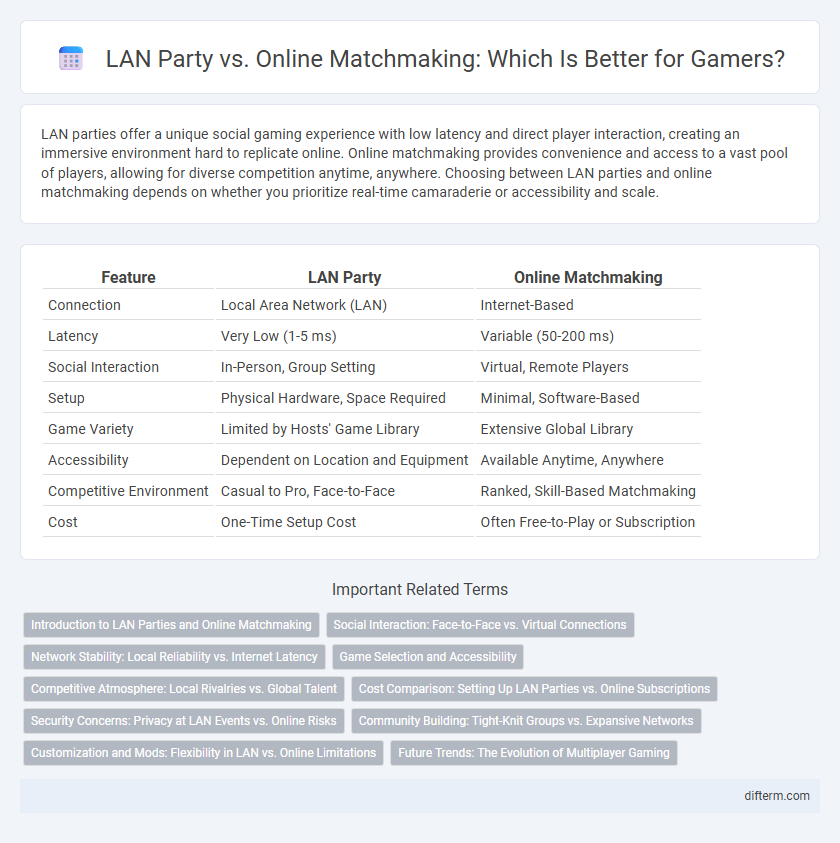LAN parties offer a unique social gaming experience with low latency and direct player interaction, creating an immersive environment hard to replicate online. Online matchmaking provides convenience and access to a vast pool of players, allowing for diverse competition anytime, anywhere. Choosing between LAN parties and online matchmaking depends on whether you prioritize real-time camaraderie or accessibility and scale.
Table of Comparison
| Feature | LAN Party | Online Matchmaking |
|---|---|---|
| Connection | Local Area Network (LAN) | Internet-Based |
| Latency | Very Low (1-5 ms) | Variable (50-200 ms) |
| Social Interaction | In-Person, Group Setting | Virtual, Remote Players |
| Setup | Physical Hardware, Space Required | Minimal, Software-Based |
| Game Variety | Limited by Hosts' Game Library | Extensive Global Library |
| Accessibility | Dependent on Location and Equipment | Available Anytime, Anywhere |
| Competitive Environment | Casual to Pro, Face-to-Face | Ranked, Skill-Based Matchmaking |
| Cost | One-Time Setup Cost | Often Free-to-Play or Subscription |
Introduction to LAN Parties and Online Matchmaking
LAN parties create a local network environment where gamers connect directly, ensuring low latency and stable connections for real-time multiplayer experiences. Online matchmaking leverages internet servers to pair players worldwide based on skill levels and game preferences, facilitating diverse competition and social interaction. Both formats offer unique advantages in gameplay dynamics, connectivity, and community building within the gaming ecosystem.
Social Interaction: Face-to-Face vs. Virtual Connections
LAN parties foster rich social interaction through face-to-face communication, enhancing teamwork and real-time camaraderie among players in the same physical space. Online matchmaking enables virtual connections that bridge geographic distances but often lack the spontaneous and nuanced social dynamics found in in-person gaming sessions. The immediacy of LAN party interactions promotes stronger social bonds, while online play offers convenience and a broader player network without physical presence.
Network Stability: Local Reliability vs. Internet Latency
LAN parties offer superior network stability due to direct local connections, minimizing packet loss and latency, which ensures smooth and consistent gameplay. Online matchmaking relies on internet connections susceptible to fluctuations in bandwidth, congestion, and server location, resulting in variable latency and potential lag spikes. The reliability of LAN environments provides competitive advantages in precision and response times compared to the unpredictability of online network conditions.
Game Selection and Accessibility
LAN parties offer a curated game selection tailored to the preferences of participants, ensuring high compatibility and optimal local performance without latency issues. Online matchmaking provides vast accessibility with millions of players worldwide, supporting diverse game titles and cross-platform play at any time. Game selection at LAN parties is often limited to locally installed titles, whereas online matchmaking enables instant access to new releases and popular competitive games through digital distribution.
Competitive Atmosphere: Local Rivalries vs. Global Talent
LAN parties foster intense local rivalries by bringing players together in the same physical space, enhancing communication and strategic coordination. Online matchmaking offers exposure to diverse global talent pools, providing varied competition levels and unique play styles. This contrast shapes player experience, with LAN emphasizing personal connections and online matchmaking broadening competitive horizons.
Cost Comparison: Setting Up LAN Parties vs. Online Subscriptions
Setting up LAN parties typically involves upfront costs such as purchasing networking equipment, renting a venue, and providing snacks or amenities, while online matchmaking requires ongoing subscription fees for platforms like Xbox Live or PlayStation Plus. LAN parties avoid monthly charges but demand considerable initial investment and coordination among players. Online subscriptions offer convenience and continuous access to multiplayer games with lower immediate expenses but accumulate higher costs over time.
Security Concerns: Privacy at LAN Events vs. Online Risks
LAN parties offer greater control over privacy since players connect through a local network with minimal exposure to external cyber threats, reducing risks like data breaches and hacking. Online matchmaking involves data transmission over the internet, increasing vulnerabilities to cyber attacks, account theft, and unauthorized data access. Players must implement strong cybersecurity measures such as VPNs, secure passwords, and firewall protection to mitigate these online security concerns.
Community Building: Tight-Knit Groups vs. Expansive Networks
LAN parties foster tight-knit gaming communities through face-to-face interaction and shared physical space, which strengthens social bonds and trust among participants. Online matchmaking expands gaming networks globally, connecting diverse players and enabling large-scale competitive play but often lacks the intimacy of local gatherings. Both platforms contribute uniquely to community building, with LAN fostering deep, personal connections and online matchmaking offering vast, dynamic player ecosystems.
Customization and Mods: Flexibility in LAN vs. Online Limitations
LAN parties offer extensive customization and modding capabilities, allowing players to tailor game settings and install community-created content without restrictions. Online matchmaking platforms often limit modifications to maintain server stability and enforce fair play, restricting players to official game versions and settings. This contrast highlights LAN's superior flexibility for personalized gaming experiences versus the standardized environment of online matchmaking.
Future Trends: The Evolution of Multiplayer Gaming
LAN parties offer low-latency, immersive multiplayer experiences that foster community bonding and local interaction, while online matchmaking provides global connectivity and diverse player pools. Advances in cloud gaming, 5G technology, and augmented reality are set to blur the lines between local and online play, enhancing accessibility and gameplay fluidity. Future multiplayer gaming will likely integrate hybrid models combining the immediacy of LAN with the expansive reach of online platforms, driving innovative social and competitive dynamics.
LAN party vs online matchmaking Infographic

 difterm.com
difterm.com